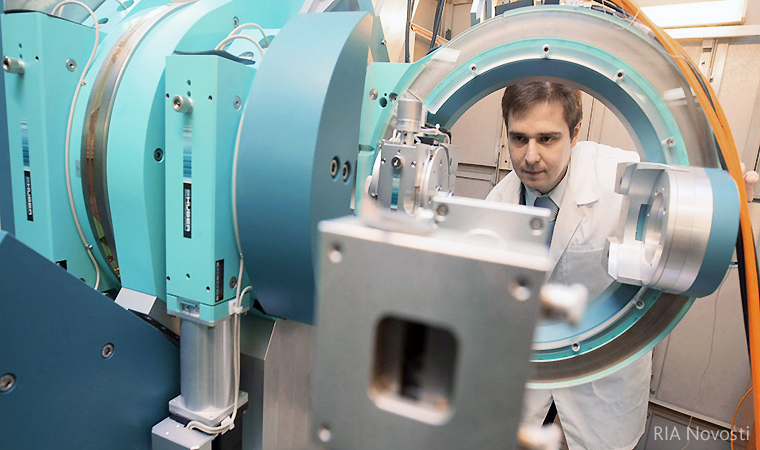
Eye for the synchrotron
back to contentsScientists are confident that this equipment will be sought-after practically in all synchrotron centers of the world. Do you want to design an electric motor of the size of a coffee grain, an internal combustion engine of the size of hundreds microns, an “excavatory” device to clean blood vessels? May be you want to decode a thin structure of biological objects or to study electronic properties of materials, diffused scattering, composition, porosity, structure, fluorescence? Synchrotron will help you with all this tasks. It represents one of the kinds of charged particle accelerators, as a rule — electrons. Particles in synchrotron are accelerated up to high speed and, hence, to high energy. During their deceleration a special kind of radiation – synchrotron radiation – is released in a magnetic field, as a matter of fact it is the same x-ray radiation, but with a much higher intensity and a number of valuable properties. It is used to study the structure and properties of the matter, while the synchrotron allows investigating objects at a nano-level.
Synchrotron emission is a by-product of accelerators operation. It is generated, when special magnets deflect charged particles, moving with a speed close to the velocity of light. Synchrotron emission was discovered in the 19th century; at first it was call the “spurious” emission, because it causes power losses of moving particles, and limits their acceleration. It was considered as inevitable evil and was strived against. However, later in the 40s of the 20th century the scientists discovered that synchrotron radiation has unique properties that can be useful to science. For the first time the synchrotron allowed the human eye see a three-dimensional internal structure of surrounding objects of submicronic size. There are more than 100 synchrotron centers in the world today.
Nanoobjects may be investigated in even more detail, if we focus the synchrotron emission. Various devices are used for this purpose, but refractive or dioptric X-ray optics is the most interesting in this sense. It uses the same principle of focusing like in all common lenses of visible light used in glasses, binoculars, cameras, however, synchrotron lenses have essentially different form, and instead of glass it is possible to use metals as the optical environment — for example, aluminium or nickel. Extra-pure grade beryllium is believed to be the best material for manufacturing of x-ray lenses, lenses made from it are especially popular. The manufacturing technique of beryllium lenses is very complex and expensive, the material is made for them only by one US company, therefore such production is very difficult-to-obtain, its market is not saturated and tends to grow. VNIINM developed the method to produce ultradisperse high-purity berillium, which has no analogues in the world. X-ray optic elements and devices made from such material shall possess unique properties. The material technology has been completed, creation of precision X-ray optic devices manufacturing technique from such material is next in turn.
“The project on creation of X-ray optic devices was started the year before last,” says Alexander Semenov, the chief expert of VNIINM. “During the work we decided to count on the new type of functional materials — X-ray optic. In this case metal is the optical medium. When passing the beryllium lenses X-ray emission is focused and dissipates just like the visible radiation by the regular lenses made from optical glass. Our task is to investigate all laws of beryllium manufacturing technique influence on its optical properties, to learn how to control them and to develop thus materials with the best optical properties. Besides, the problem of high-precision manufacturing of beryllium lenses to be solved is very difficult and interesting for us.”
The Baltic State University named after I.Kant, one of VNIINM partners in the project, performed researches of unique beryllium materials of the Russian manufacture in Grenoble European Synchrotron Radiation Facility (ESRF). In December of last year VNIINM experts manufactured experimental samples of X-ray optic devices and transferred them for researches to Kurchatovsky institute. Crystallography Institute of the Russian Academy of Sciences named after A.V.Shubnikov helped perform a complex of their research tests using the Kurchatovsky synchrotron radiation source, including tomography. In the near future it is necessary to study their focusing ability in relation to X-ray radiation of various energies. Almost all world centers of synchrotron radiation, sources of neutron radiation and national laboratories are the potential consumers of X-ray optic devices.
“If the planned tests on Kurchatovsky institute synchrotron show that our experts achieved the necessary characteristics for X-ray lenses manufacturing, then we can manufacture them ourselves for the end user and transfer the manufacturing techniques of this high technology production to the customers,” said Valentine Ivanov, VNIINM director.




